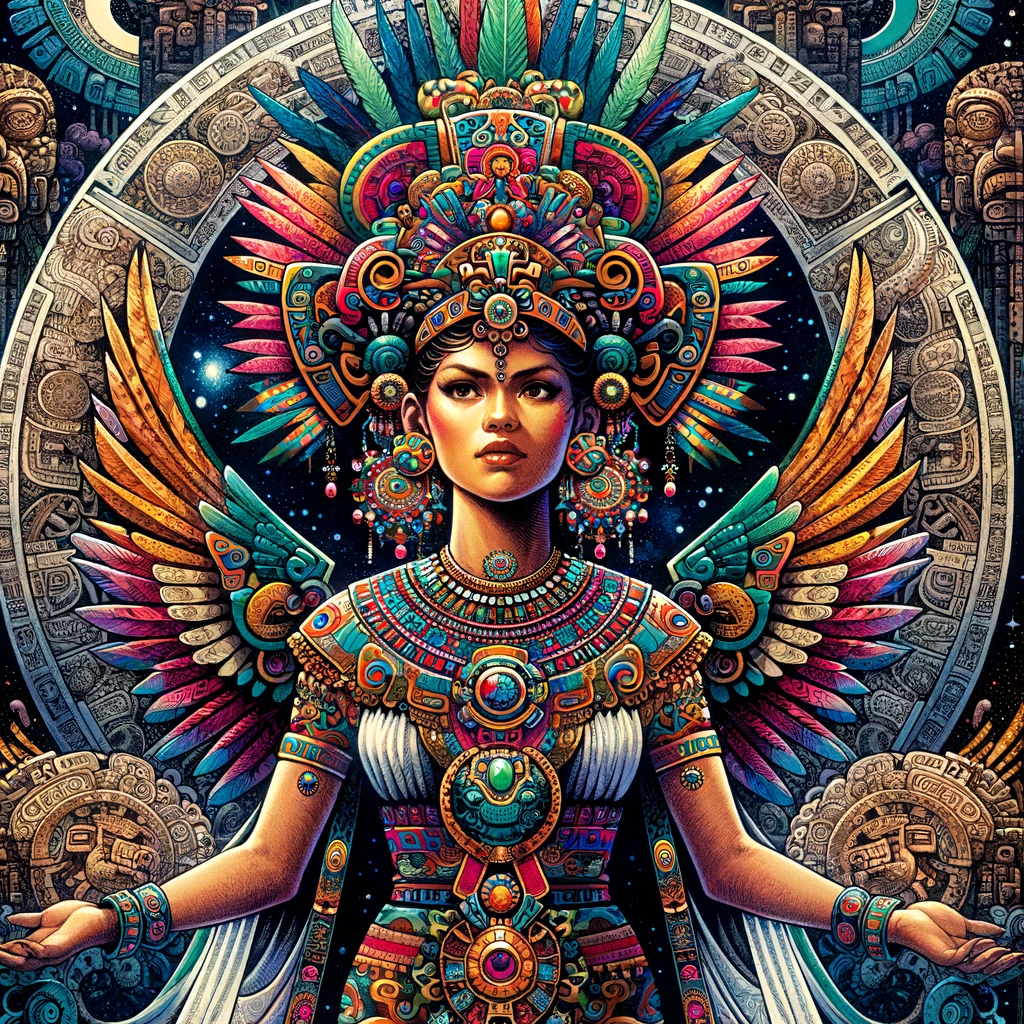
Omecihuatl: Aztec Goddess of Creation
In the rich pantheon of Aztec mythology, few deities are as enigmatic and compelling as Omecihuatl. Known also as Omecíhuatl or Ometecuhtli when combined with her male counterpart, this deity stands at the center of the Aztec cosmogony as a symbol of duality and creation.
Origins and Etymology
The name "Omecihuatl" is derived from the Nahuatl language, where "ome" translates to "two" and "cihuatl" means "woman." This name reflects her role as the female aspect of the dual god Ometeotl, embodying the concept of gender duality that was central to Aztec religion and cosmology.
Role in Aztec Mythology
Omecihuatl is often depicted as a consort to Ometecuhtli, with whom she resides in Omeyocan, the highest of the thirteen heavens. Together, they are said to have given birth to the four Tezcatlipocas, who in turn created the world. This narrative highlights her crucial role in the creation story and the perpetuation of life and existence.
Symbolism and Worship
As a deity, Omecihuatl represents the female principle, linked with fertility, creation, and duality. However, unlike many other deities in the Aztec pantheon, there is little evidence to suggest that she was actively worshipped with temples or rituals. Instead, her influence is more conceptual, representing the balance and unity of opposites in the universe.
Interpretations and Legacy
Modern interpretations of Omecihuatl often view her as a representation of the balance between male and female energies, as well as the interconnectedness of all things. In a broader sense, she symbolizes the fundamental principles of life and existence, making her an enduring figure in the study of Aztec mythology and philosophy.
Conclusion
Omecihuatl's role in Aztec mythology, while not as prominently visible as other gods and goddesses, is nonetheless integral. Her representation of duality, creation, and the balance of cosmic forces continues to fascinate scholars and enthusiasts of Mesoamerican cultures. As we delve deeper into the ancient Aztec world, figures like Omecihuatl offer us a glimpse into the complex and rich spiritual landscape of this great civilization.
In the rich pantheon of Aztec mythology, few deities are as enigmatic and compelling as Omecihuatl. Known also as Omecíhuatl or Ometecuhtli when combined with her male counterpart, this deity stands at the center of the Aztec cosmogony as a symbol of duality and creation.
Origins and Etymology
The name "Omecihuatl" is derived from the Nahuatl language, where "ome" translates to "two" and "cihuatl" means "woman." This name reflects her role as the female aspect of the dual god Ometeotl, embodying the concept of gender duality that was central to Aztec religion and cosmology.
Role in Aztec Mythology
Omecihuatl is often depicted as a consort to Ometecuhtli, with whom she resides in Omeyocan, the highest of the thirteen heavens. Together, they are said to have given birth to the four Tezcatlipocas, who in turn created the world. This narrative highlights her crucial role in the creation story and the perpetuation of life and existence.
Symbolism and Worship
As a deity, Omecihuatl represents the female principle, linked with fertility, creation, and duality. However, unlike many other deities in the Aztec pantheon, there is little evidence to suggest that she was actively worshipped with temples or rituals. Instead, her influence is more conceptual, representing the balance and unity of opposites in the universe.
Interpretations and Legacy
Modern interpretations of Omecihuatl often view her as a representation of the balance between male and female energies, as well as the interconnectedness of all things. In a broader sense, she symbolizes the fundamental principles of life and existence, making her an enduring figure in the study of Aztec mythology and philosophy.
Conclusion
Omecihuatl's role in Aztec mythology, while not as prominently visible as other gods and goddesses, is nonetheless integral. Her representation of duality, creation, and the balance of cosmic forces continues to fascinate scholars and enthusiasts of Mesoamerican cultures. As we delve deeper into the ancient Aztec world, figures like Omecihuatl offer us a glimpse into the complex and rich spiritual landscape of this great civilization.